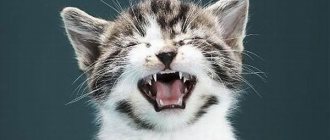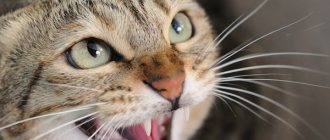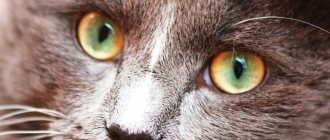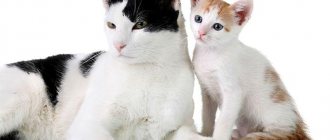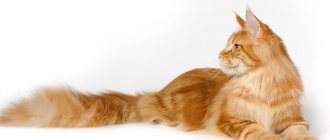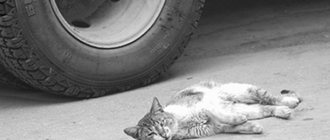The size and physiological maturation of animals depend on a large number of different factors. To know exactly to what age cats grow, it is necessary to take into account their breed, the functioning of the endocrine glands and their general health. Proper care and the creation of suitable conditions can affect the growth of a pet.
Age at which cats grow
Full physiological maturation of the animal occurs with puberty. However, growth continues for some time. The average age at which cats stop growing is from 1 to 3 years. The exact time depends on several internal and external factors, including the characteristics of the content and breed. Height does not include obesity.
There are 5 stages of cat maturation:
- Neonatal - from birth to 4 days. At this time, the kitten’s weight either increases or decreases.
- Suction - from 5 days to 1 month. The animal is actively growing and developing.
- Transitional - from 1 to 1.5 months. During this period, growth slows down somewhat. New products are being introduced to the pet's menu.
- Adolescence - from 4 months to 1 year, when growth is activated again and continues until full puberty, that is, readiness for reproduction.
Starting from 1 year, the cat is considered independent.
What to do if your Bengal begins to gain weight poorly
Having noticed deviations in weight gain, you should determine the reasons for this.
Bengals are one of the cat breeds that lead an active lifestyle.
A few common reasons:
- Poor nutrition. Underweight occurs if the kitten is malnourished or does not receive enough nutritional components. Make sure that the kitten eats 6 times a day and has constant access to clean drinking water.
- Refusal to eat. This problem especially often occurs among owners who purchased a kitten from a breeder. The pet may already be accustomed to a certain food and refuse to eat a new one. In this case, you should transfer the kitten to a new food gradually.
- Stress. Sudden changes in environment and other factors can provoke stress. When stressed, kittens may refuse to eat. As a rule, adaptation takes from a couple of days to a week, after which the pet begins to eat normally and gain weight again.
- Diseases. If a Bengal eats properly, but still does not gain weight well, this may indicate diseases of the digestive system. In this case, you should definitely show your pet to a veterinarian.
- Parasites. Weight loss may indicate the presence of worms. Prevention against parasites should be carried out every six months starting from three weeks of age. For kittens, a suspension is used: it is easier to administer into the body.
Be sure to read:
Cat and cat of the American Curl breed, varieties: semi-longhair and shorthair
Factors affecting dimensions
The growth and maturation of a cat is influenced by external factors and features of physiological development. These include:
- Breed is one of the most important factors affecting the height and weight of an adult animal, as well as the age at which it reaches adulthood. In outbred domestic cats, the genotype is most often mixed, so it is unlikely that it will be possible to determine the exact timing of development. Some kittens grow up to 3 years old, while others reach their maximum height and weight by one year.
- Heredity - the size of an animal largely depends on the size of its parents. It is extremely rare for small cats to give birth to large kittens.
- Gender of the animal - males always grow larger and heavier than females.
- Living conditions - growth is influenced by a comfortable room temperature, sufficient light, good restful sleep and the baby’s nutrition.
- State of health and presence of any diseases. The pathology can be any - somatic, infectious, parasitic or genetically determined. The correct functioning of the endocrine glands is also important.
- Physical activity and lifestyle - the more a kitten moves and plays, the better it grows. His body develops proportionally, and his weight is normal for his age and breed.
- Castration, especially performed in adulthood. Cats that are sterilized at the age of 2-3 years and older grow larger than those that were neutered before a year or were not sterilized at all.
Early mating before the age of 1 year leads to a slowdown or complete cessation of the animal’s growth.
Causes of delayed development
It often happens that a cat lags behind the growth standards inherent in its age and breed. There are several reasons for this phenomenon:
- Wrong diet. If a kitten’s menu lacks vitamins, protein and microelements, the animal will gain weight poorly and lag behind in physiological development.
- Diseases - these can be bacterial and viral infections, autoimmune and hereditary conditions.
- Congenital or acquired hormonal disorders. The most common cause of slow growth is sterilization too early. This operation leads to a change in the hormonal background of the animal, and, as a result, to a change in metabolism. Gradually the animal's condition is restored, but this takes more time. Other endocrine causes may include adrenal or thyroid disease.
- Helminthiasis is infection by parasites. If worms or other parasites appear in the animal's intestines, they deprive the kitten of a significant part of its nutrients. As a result, growth and development slows down.
- Prolonged stay at low ambient temperatures. It has been noticed that in the cold season pets grow more slowly. The optimal air temperature for good development is 22...25 °C.
Why is my pet growing slowly?
To understand how long kittens grow, you need to pay attention to their lifestyle. There are many different factors that cause animal growth to slow down.
There are many reasons for a cat's slow growth
Care and habitat
Living conditions are very important for the development of a pet. Outdoor cats suffer significantly in development due to lack of proper care. This happens due to vitamin deficiency and weakened immunity.
Hormonal imbalance
Hormonal imbalances can slow down the development of an animal, but after some time it can begin to grow rapidly again. This is especially true for castrated males.
Presence of parasites in the body
If a kitten has worms, this will inevitably lead to slower growth. Worm infestations are dangerous for any pet of any age. The animal may even die.
Taking hormonal medications
Hormonal drugs, despite the prevalence of their use, can have a negative effect on the animal, slowing down its growth and development.
Important! The drugs can have a negative effect on the hormonal levels of purebred cats.
Passive lifestyle
It is known that pets leading a passive lifestyle grow more slowly, and their body may be disproportionate in development.
If a cat moves little, its muscular system stops growing, circulatory processes are disrupted, and concomitant diseases arise, for example, diabetes.
Important! Early mating can negatively affect the development of the pet.
Past viral diseases
Often, lack of weight is a consequence of past illnesses. Infections can affect a kitten’s fragile body, leading to disturbances in the gastrointestinal tract and deterioration in the absorption of substances. Organs do not receive enough nutrients from the blood, growth slows down and weight gain also slows down.
Dependence on breed
The age at which a cat grows largely depends on the breed .
British cats are especially popular among pet lovers. This breed is distinguished by a short, bluish-gray coat that resembles a plush one. The expression on their faces can be very funny, and their disposition can be light and affectionate.
Females of this breed gain weight up to 6 kg, and after sterilization they can grow up to 8 kg. An adult British cat gains up to 8 kg of body weight, and after castration, up to 10 kg. The age at which British cats grow is 3 years; in female cats, maturation occurs faster - by 1.5 years. If pregnancy occurs, growth is interrupted during this time, but then the female makes up for the lack of weight.
The Scots have growth parameters and development periods that coincide with the British. But Scottish kittens have a more balanced character.
In sphinxes, puberty begins early. Cats can stop growing as early as 5-6 months, at which time they can become pregnant. Sphynx cats grow until about 2.5 years of age. An adult cat can weigh from 2 to 4 kg, and a male cat can weigh from 4 to 6 kg. The breed is prone to overeating and gaining excess weight. This is easy to identify by body shape, since sphinxes do not grow hair. It is very important to monitor their diet.
Maine Coons are considered the largest of all domestic purebred cats. This breed originates in North America. The weight of an adult male after castration is usually within 10 kg. However, they are distinguished by strong bones, wide paws and long fluffy hair. This increases the size of Maine Coons visually. The record holder of the breed is a cat whose length from nose to tip of tail is 1 m 23 cm.
Since this breed is generally large in size, kittens take a long time to grow. In the first year of life, their growth is most intense. At the age of 4 months, a Maine Coon kitten looks like an adult cat of another breed. Its body weight is about 4 kg. At the age of 11-12 months, growth slows down somewhat. Complete growth occurs at 3.5 years. By this time, females weigh up to 8.5 kg, and males up to 12 kg.
Siberian cats and cats are a breed formed in the natural conditions of Western Siberia and the Urals. They are distinguished by their strong build and good health. These animals are massive, they have a wide head, and the body is set low. Siberian cats grow up to 3 years old, the weight of males reaches 10 kg, and females - 6 kg.
Bengal cats mature a little earlier. Females of this breed grow up by 9 months, and males by 2 years. Bengals are not large in size and weigh no more than 6 kg.
Infancy and childhood
The first period in kittens lasts several weeks. They are born blind and deaf. The film protecting the cats' ears disappears within the first week, and the eyes open within ten days. Milk teeth erupt at 3-4 weeks.
At one month of age, kittens are already actively running around the house and showing curiosity. They do it like one and a half year old children.
Kittens develop at a rapid pace; at two months their age is comparable to five years of a child’s life. The fluffy little ball already eats on its own, knows how to communicate with its brothers and people, and begins to care for its fur without its mother. He already knows where his household members are and where strangers are, and relieves himself in the litter box.
If we draw a parallel with the rate of development of cats and children, then in a week the former mature as much as children do in several months. Therefore, it is important to instill in kittens good manners in a short time and accustom them to certain rules of behavior in the house.
Content recommendations
The answer to the question of how long cats grow depends largely on proper care. Owners need to create the most suitable conditions for their pets. First of all you need to:
- Maintaining hygiene is no less important for cats than for people. The pet must always be clean and well-groomed. Once a month, the cat needs to be bathed and thoroughly brushed. The cat's litter box should be emptied regularly and the filling should be changed, and the food bowl should be thoroughly washed several times a week.
- Once a quarter, helminthiasis prevention should be carried out. This is done with the help of special drugs. You can find out the exact name and dosage from your doctor.
- If the animal suffers from any chronic disease, it is necessary to regularly see the veterinarian. Take courses of treatment or prevention as prescribed.
- Comprehensive vaccinations against feline infections need to be updated annually. Thanks to this measure, the cat’s risk of contracting a viral, bacterial or fungal infection is reduced. This also applies to pets who do not leave the apartment. Owners can bring the infectious agent on shoes or clothing.
- Proper nutrition plays an important role. There are special cat foods with vitamin and mineral supplements on sale. If the animal eats natural products, medications are purchased separately.
- You should not expose your cat to unnecessary stress - yell at him, physically punish him, etc. Jealousy has a bad effect on the animal’s psyche.
- Early mating will not benefit the cat's health. If a pet becomes pregnant before a year, she may experience hormonal imbalances and developmental arrest. The female’s body will devote all its strength to bearing offspring, and the cat herself may become seriously ill or die from exhaustion.
Compliance with these conditions will help raise a healthy and strong animal that will delight the owner for many years.
